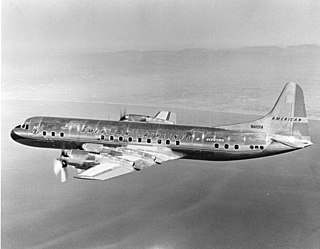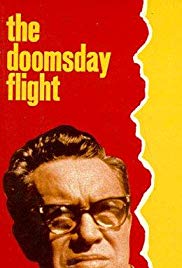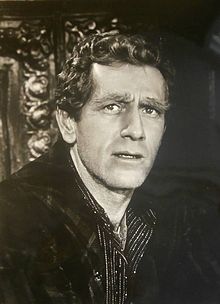"The Arrival" is the second episode of the third season and 67th overall episode of the American television anthology series The Twilight Zone. It was written by the series' creator and showrunner Rod Serling, and was directed by Boris Sagal.

Pacific Southwest Airlines Flight 1771 was a scheduled flight along the West Coast of the United States, from Los Angeles, California, to San Francisco. On December 7, 1987, the British Aerospace 146-200A, registration N350PS, crashed in San Luis Obispo County near Cayucos, after being hijacked by a passenger.

Eastern Air Lines Flight 401 was a scheduled flight from New York JFK to Miami. Shortly before midnight on December 29, 1972, the Lockheed L-1011-1 TriStar crashed into the Florida Everglades, causing 101 total fatalities. All three cockpit crew members, two of the 10 flight attendants, and 96 of the 163 passengers were killed; 75 people survived.

Avianca Flight 011, registration HK-2910X, was a Boeing 747-200M on an international scheduled passenger flight from Frankfurt to Bogotá via Paris, Madrid, and Caracas that crashed near Madrid on 27 November 1983. It took off from Charles de Gaulle Airport in Paris at 22:25 on 26 November 1983 for Madrid Barajas Airport; take-off was delayed waiting for additional passengers from a Lufthansa flight due to a cancellation of the Paris-Frankfurt-Paris segment by Avianca for operational reasons.
New York Airways was an American helicopter airline in the New York City area, founded in 1949 as a mail and cargo carrier. On 9 July 1953 it may have been the first scheduled helicopter airline to carry passengers in the United States, with headquarters at LaGuardia Airport. Although primarily a helicopter airline operator with scheduled passenger operations, New York Airways also flew fixed wing aircraft, such as the de Havilland Canada DHC-6 Twin Otter 19-passenger STOL twin turboprop aircraft.

On December 16, 1960, a United Airlines Douglas DC-8 bound for Idlewild Airport in New York City collided in midair with a TWA Lockheed L-1049 Super Constellation descending toward LaGuardia Airport. The Constellation crashed on Miller Field in Staten Island and the DC-8 in Park Slope, Brooklyn, killing all 128 aboard the two aircraft and six people on the ground. The accident was the world's deadliest aviation disaster at the time, and remains the deadliest accident in the history of United Airlines.

USAir Flight 405 was a regularly scheduled domestic passenger flight between LaGuardia Airport in Queens, New York City, New York, and Cleveland, Ohio. On March 22, 1992, a USAir Fokker F28, registration N485US, flying the route, crashed in poor weather in a partially inverted position in Flushing Bay, shortly after liftoff from LaGuardia. The undercarriage lifted off from the runway, but the airplane failed to gain lift, flying only several meters above the ground. The aircraft then veered off the runway and hit several obstructions before coming to rest in Flushing Bay, just beyond the end of the runway. Of the 51 people on board, 27 were killed, including the captain and a member of the cabin crew.

American Airlines Flight 320 was a scheduled flight between Chicago Midway International Airport and New York City's LaGuardia Airport. On February 3, 1959, the Lockheed L-188 Electra performing the flight crashed into the East River during its descent and approach to LaGuardia Airport, killing 65 of the 73 people on board. Weather conditions in the area were poor, which meant that the crew had to descend through dense clouds and fog. The aircraft flew lower than the pilots intended and it crashed into the icy river 4,900 feet (1,500 m) short of the runway at a speed of 140 knots. American Airlines had been flying the newly-developed Lockheed Electra in commercial service for only about two weeks before the accident.

Pacific Air Lines Flight 773 was a Fairchild F27A Friendship airliner that crashed on May 7, 1964, near Danville, California, a suburb east of Oakland. The Thursday morning crash was most likely the first instance in the United States of an airliner's pilots being shot by a passenger as part of a murder–suicide. Francisco Paula Gonzales, 27, shot both pilots before turning the gun on himself, causing the plane to crash, killing all 44 aboard.

Continental Airlines Flight 1713 was a commercial airline flight that crashed while taking off in a snowstorm from Stapleton International Airport in Denver, Colorado, on November 15, 1987. The Douglas DC-9 airliner, operated by Continental Airlines, was making a scheduled flight to Boise, Idaho. Twenty-five passengers and three crew members died in the crash.

Copa Airlines Flight 201 was a regularly scheduled passenger flight from Tocumen International Airport in Panama City, Panama, to Alfonso Bonilla Aragón International Airport in Cali, Colombia. On 6 June 1992, the Boeing 737-204 Advanced operating the route rolled, entered a steep dive, disintegrated in mid-air, and crashed into the jungle of the Darién Gap 29 minutes after takeoff, killing all 47 people on board. The in-flight break-up was caused by faulty instrument readings and several other contributing factors, including incomplete training.

USAir Flight 5050 was a passenger flight that crashed on takeoff from LaGuardia Airport in Queens, New York. As the plane took off from LaGuardia's runway 31, the plane drifted to the left. After hearing a loud bang, the pilots attempted to reject the takeoff, but were unable to stop the plane short of the end of the runway. The plane continued past the end of the runway and plunged into Bowery Bay. Two passengers were killed.

China Airlines Flight 120 was a regularly scheduled flight from Taiwan Taoyuan International Airport in Taoyuan County, Taiwan to Naha Airport in Okinawa, Japan. On August 20, 2007, the Boeing 737-800 aircraft operating the flight caught fire and exploded after landing and taxiing to the gate area at Naha Airport. Four people—three from the aircraft and one ground crew—sustained injuries in the accident. The fire had been caused by a loose bolt puncturing a fuel tank.

On April 27, 2012, a multinational team of television studios staged an airplane crash near Mexicali, Mexico. An unmanned Boeing 727-200, fitted with numerous cameras, crash test dummies and other scientific instruments, was flown into the ground. The exercise was filmed for television.

Southwest Airlines Flight 345 was a scheduled flight from Nashville International Airport, Tennessee, to New York City's LaGuardia Airport. On July 22, 2013, the Boeing 737 operating the route suffered a front landing gear collapse while landing at LaGuardia Airport, injuring 9 people on board. The aircraft, which was worth an estimated $15.5 million at the time, was written off and scrapped as a result of the accident.

LAM Mozambique Airlines Flight 470 was a scheduled international passenger flight from Maputo, Mozambique, to Luanda, Angola. On 29 November 2013, the Embraer E190 twinjet operating the service crashed into the Bwabwata National Park in Namibia, halfway through its flight, killing all 27 passengers and 6 crew on board.

The Doomsday Flight is a 1966 American thriller television film written by Rod Serling and directed by William Graham. The cast includes Jack Lord, Edmond O'Brien, Van Johnson, Katherine Crawford, John Saxon, Richard Carlson and Ed Asner. It aired on NBC on December 13, 1966.

Delta Air Lines Flight 1086 was a scheduled Delta Air Lines domestic passenger flight between Atlanta and New York's LaGuardia Airport. On March 5, 2015, the McDonnell Douglas MD-88 aircraft veered off the runway shortly after landing at LaGuardia Airport in New York City. The plane ran up the seawall berm and struck the perimeter fence, sliding along it for approximately 940 feet (290 m) before coming to rest with the nose of the aircraft hanging over the berm above Flushing Bay. There were no fatalities, although 29 people suffered minor injuries. The aircraft was seriously damaged and written off.

















